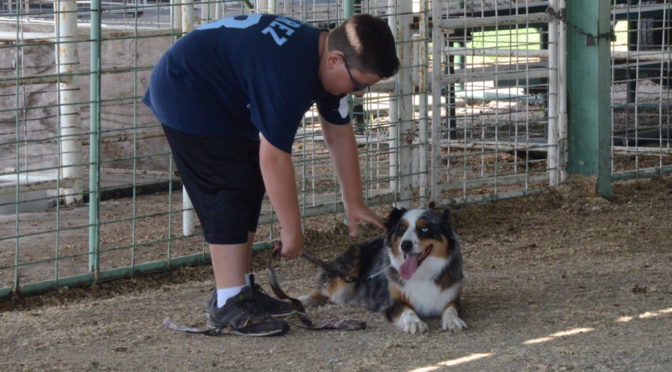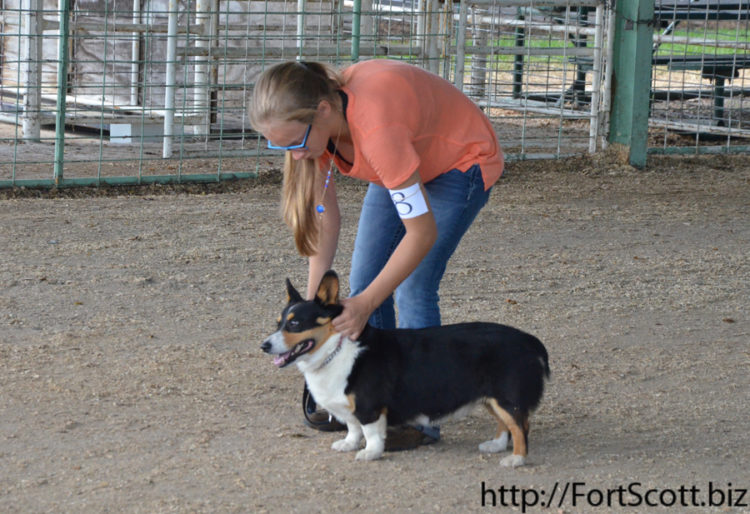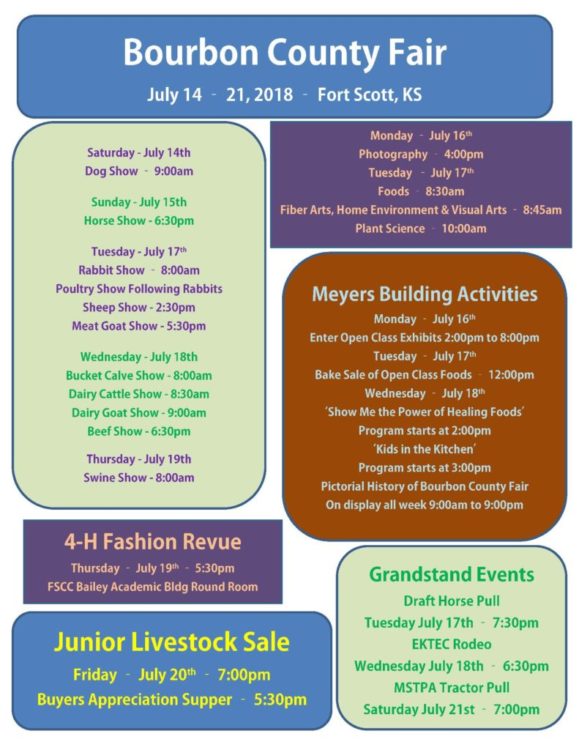
” In Bourbon County, the opportunities in 4-H are truly infinite,” Jennifer Terrell, K-State District 4-H Youth Development Agent, said. “Youth ages 7-18 are eligible to participate as full-fledged 4-H members. For those youth ages 5 and 6, there is a Cloverbud Program. Beyond being a member of the monthly community club, youth are encouraged to attend projects meetings, 4-H Camp, 4-H Days, the County Fair, and other State 4-H Events.”
” At the Bourbon County Fair, 4-H members pre-enter to exhibit in the 4-H Division and other youth may participate in Open Class,” Terrell said. “Families considering being involved in 4-H are encouraged to visit the county fair to view all of the hard work.”
The following is a press release from Terrell and the poster of the events of the fair:
“It is county fair time across the State of Kansas! While you may attend the fair as a form of entertainment, 4-H’ers and their families know this is time to display the hard work put into their year-long project learning in the 4-H Program.
While visiting the county fair, it is hard to miss the different colored ribbons or stickers placed on the exhibits.
Have you ever wondered why there are different colors and how that came about? Well, I am going to share with you the judging process.
In 4-H most judging involves the Danish System of judging. In this system, the judges do not judge one person’s work by comparing it to another’s. The evaluation is made against a standard.
A judge looks to see whether requirements are met. Exhibits are placed into four ribbon groups.
The best ribbon placing is purple which means the project is outstanding on all standards.
Blue means it exceeds the minimum standard and may have minor flaws where improvements can be made.
The ribbon placing that meets all minimum standards and may show visible signs of needed improvements is red.
And projects failing to meet minimum standards receive a white.
One advantage of this system is that everyone whose work fulfills minimum qualifications can receive a ribbon. If all entries are judged to be excellent, all receive blue ribbons.
The purpose of using the Danish System is to give every 4-H member the recognition deserved for the work that was done. It also helps young people recognize the need to improve their skills and to “make the best better.”
So, how did that ribbon placing come about you might be asking?
You should know that having one’s accomplishments evaluated can be motivating and educational for 4-H’ers.
When judges critique their work or performance, it serves as a guide to further improvement. The judging process is probably more valuable than the award or recognition. To plan, practice, and present a finished product is to “learn by doing.” To graciously accept constructive criticism of one’s work is a real life experience. 4-H’ers learn quickly that judging results reflect a personal opinion, and that evaluation will vary among judges.
There are three different types of evaluation in 4-H.
The first is conference or interview. This is where the judge will interview the participant as he/she evaluates the product against a set of standards. The purpose of this is to determine what the 4-H’er learned in completing the project. Comments are provided verbally mostly, but can also be found written on a score sheet.
Another way 4-H’ers are evaluated with their projects is performance judging. The judge evaluates how a 4-H’er accomplishes a task or a goal in progress. The judge looks for skills being used, as well as evaluating the end result. This type of event enables the 4-H’er and the judge to see how the performance directly effects the end product. Comments are often provided verbally and also in writing on a score sheet.
And the final type of evaluation is project judging. The judge evaluates the finished products against a set of standards without the member present. The focus is the quality of the project itself and not the learning process. Comments are provided to the participant in writing, usually on a score sheet.
As you have read, there is a lot to know and understand with the judging process of projects in 4-H. It is not something taken lightly.
I encourage you to visit your local county fair this year to view all of the exhibits and pay close attention to those 4-H exhibits. And maybe for fun evaluate the exhibits and see what placings you would give.
For more information on 4-H Youth Development, give me a call at 620-244-3826 or email at [email protected].”


